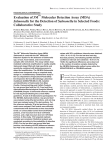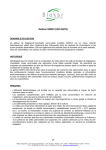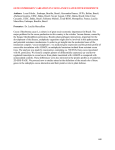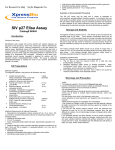Download 2013.09 - AOAC International
Transcript
AOAC Official Method 2013.09 Salmonella in Selected Foods 3M™ Molecular Detection Assay (MDA) Salmonella Method First Action 2013 Revised First Action 2014 A. Principle B. Apparatus and Reagents Items (b)–(g) are available as the 3M MDA Salmonella kit from 3M Food Safety (St. Paul, MN, USA). (a) 3M Molecular Detection System.—Available from 3M Food Safety. (b) 3M MDA Salmonella reagent tubes.—Twelve strips of eight tubes. (c) Lysis solution (LS) tubes.—Twelve strips of eight tubes. (d) Extra caps.—Twelve strips of eight caps. (e) Negative control (NC).—One vial (2 mL). (f) Reagent control.—Eight reagent tubes. Ex A pe OA rt C R R ev es ie ea w rc Pa h ne Ins l U tit se ute O nl y [Applicable to detection of Salmonella in raw ground beef (25, 325, and 375 g), raw ground chicken (25 and 325 g), cooked breaded chicken (325 g), pasteurized liquid whole egg (100 g), raw shrimp (head-off, 25 g), fresh spinach (bagged, 25 g), wet dog food (375 g), pasteurized American cheese (25 g), peanut butter (25 g), dry dog food (25 and 375 g), sprout irrigation water (375 g), raw head-on shrimp (25 g), chicken carcass rinsate (30 mL), chicken carcass sponge, sealed/glazed ceramic tile, concrete, and stainless steel.] See Tables 2013.09A and B for a summary of results of the interlaboratory study. See Tables 1 and 2 of the Appendix for detailed results of the interlaboratory study (appendix is available on the J. AOAC Int. website, http://aoac.publisher.ingentaconnect.com/content/aoac/ jaoac). efficiency, and rapidity, and bioluminescence to detect the amplified sequences. Presumptive positive results are reported in real-time; negative results are displayed after the assay is completed. The LOD of a method is defined as the lowest concentration point where reliable analytical results can be obtained. This can vary with different serotypes. For the 3M MDA Salmonella method this has been demonstrated to be 1–5 CFU/25 g of sample or 1–5 CFU/swab. As with all test methods, the source of enrichment medium can influence the results. The 3M MDA Salmonella method has only been evaluated for use with the enrichment medium, 3M Buffered Peptone Water ISO (BPW ISO). Matrixes are incubated in 3M BPW for 10–24 h to enrich for Salmonella prior to initiating the assay, with the exception of raw head-on shrimp, which requires an additional 4–24 h secondary enrichment in RappaportVassiliadis 10 broth (RV10). The 3M MDA Salmonella method is intended for use with the 3M Molecular Detection System for the rapid and specific detection of Salmonella spp. in food, food-related, and environmental samples after enrichment. The 3M MDA Salmonella test uses isothermal amplification of unique DNA target sequences with high specificity, Table 2013.09A. POD summary of raw ground beef (25 g) results for the 3M MDA Salmonella methoda Inoculation level Candidate presumptive positive/total No. of samples analyzed Uninoculated Low High 1/120 69/120 120/120 Candidate presumptive (CP) POD 0.01 (0.00, +0.05) 0.58 (+0.48, +0.67) 1.00 (+0.97, +1.00) srb 0.09 (+0.08, +0.17) 0.51 (+0.45, +0.52) 0.00 (0.00, +0.18) 0.00 (0.00, +0.04) 0.00 (0.00, +0.14) 0.00 (0.00, +0.18) 0.09 (+0.08, +0.10) 0.51 (+0.45, +0.52) 0.00 (0.00, +0.24) sL c sRd 0/120 67/120 120/120 Candidate confirmed (CC) POD Candidate confirmed positive/total No. of samples analyzed 0.00 (0.00, +0.03) 0.56 (+0.47, +0.65) 1.00 (+0.97, +1.00) sr 0.00 (0.00, +0.17) 0.51 (+0.45, +0.52) 0.00 (0.00, +0.18) 0.00 (0.00, +0.17) 0.00 (0.00, +0.11) 0.00 (0.00, +0.18) 0.00 (0.00, +0.24) 0.51 (+0.46, +0.52) 0.00 (0.00, +0.24) 0/120 68/120 119/120 sL sR Positive reference samples/total No. of samples analyzed Reference POD 0.00 (0.00, +0.03) 0.57 (+0.48, +0.66) 0.99 (+0.95, +1.00) sr 0.00 (0.00, +0.17) 0.50 (+0.45, +0.52) 0.09 (+0.08, +0.17) sL 0.00 (0.00, +0.17) 0.00 (0.00, +0.18) 0.00 (0.00, +0.04) sR 0.00 (0.00, +0.24) 0.51 (+0.45, +0.52) 0.09 (+0.08, –0.11) dLPOD (candidate vs reference) 0.00 (–0.03, +0.03) –0.01 (–0.14, +0.12) 0.01 (–0.02, +0.05) dLPOD (CP vs CC) 0.01 (–0.02, +0.05) 0.02 (–0.11, +0.15) 0.00 (–0.03, +0.03) a Results include 95% confidence intervals. b Repeatability standard deviation. c Among-laboratory standard deviation. d Reproducibility standard deviation. © 2014 AOAC INTERNATIONAL Table 2013.09B. POD Summary of wet pet food (375 g) results for the 3M MDA Salmonella methoda Inoculation level Uninoculated Candidate presumptive positive/total No. of samples analyzed Low High 1/132 65/132 131/132 Candidate presumptive (CP) POD 0.01 (0.00, +0.04) 0.49 (+0.40, +0.58) 0.99 (+0.96, +1.00) srb 0.09 (+0.08, +0.16) 0.51 (+0.46, +0.52) 0.09 (+0.08, +0.16) sLc 0.00 (0.00, +0.04) 0.00 (0.00, +0.14) 0.00 (0.00, +0.04) sR 0.09 (+0.08, +0.10) 0.51 (+0.46, +0.52) 0.09 (+0.08, +0.10) 0/132 65/132 131/132 d Candidate confirmed positive/total No. of samples analyzed Candidate confirmed (CC) POD 0.00 (0.00, +0.03) 0.49 (+0.40, +0.58) 0.99 (+0.96, +1.00) sr 0.00 (0.00, +0.17) 0.51 (+0.46, +0.52) 0.09 (+0.08, +0.16) sL 0.00 (0.00, +0.17) 0.00 (0.00, +0.14) 0.00 (0.00, +0.04) sR 0.00 (0.00, +0.23) 0.51 (+0.46, +0.52) 0.09 (+0.08, +0.10) Reference POD sr sL sR 0/132 70/132 132/132 0.00 (0.00, +0.03) 0.53 (+0.44, +0.62) 1.00 (+0.97, +1.00) 0.00 (0.00, +0.17) 0.52 (+0.46, +0.52) 0.00 (0.00, +0.17) 0.00 (0.00, +0.17) 0.00 (0.00, +0.09) 0.00 (0.00, +0.17) Ex A pe OA rt C R R ev es ie ea w rc Pa h ne Ins l U tit se ute O nl y Positive reference samples/total No. of samples analyzed 0.00 (0.00, +0.23) 0.52 (+0.47, +0.52) 0.00 (0.00, +0.23) dLPOD (candidate vs reference) 0.00 (–0.03, +0.03) –0.04 (–0.16, +0.09) –0.01 (–0.04, +0.02) dLPOD (CP vs CC) 0.01 (–0.02, +0.05) 0.00 (–0.13, +0.13) 0.00 (–0.03, +0.03) a Results include 95% confidence intervals. b Repeatability standard deviation. Among-laboratory standard deviation. c d Reproducibility standard deviation. (g) Quick start guide. (h) 3M Molecular Detection Speed Loader Tray.—Available from 3M Food Safety. (i) 3M Molecular Detection Chill Block Tray and Chill Block Insert.—Available from 3M Food Safety. (j) 3M Molecular Detection Heat Block Insert.—Available from 3M Food Safety. (k) 3M Molecular Detection Cap/Decap Tool for reagent tubes.—Available from 3M Food Safety. (l) 3M Molecular Detection Cap/Decap Tool for lysis tubes.— Available from 3M Food Safety. (m) Empty lysis tube rack.—Available from 3M Food Safety. (n) Empty reagent tube rack.—Available from 3M Food Safety. (o) 3M BPW ISO.—Available from 3M Food Safety. Formulation equivalent to ISO 6579:2002 Annex B (1). (p) Rappaport-Vassiliadis 10 broth (RV10).—Available from 3M Food Safety. (q) Disposable pipet.—Capable of 20 µL. (r) Multichannel (eight-channel) pipet.—Capable of 20 µL. (s) Sterile filter tip pipet tips.—Capable of 20 µL. (t) Filter stomacher bags.—Seward Laboratory Systems, Inc. (Bohemia, NY, USA), or equivalent. (u) Stomacher.—Seward Laboratory Systems Inc., or equivalent. (v) Thermometer.—Calibrated range to include 100 ± 1°C. (w) Dry double block heater unit or water bath.—Capable of maintaining 100 ± 1°C. (x) Incubators.—Capable of maintaining 37 ± 1°C and 41.5 ± 1°C. (y) Freezer.—Capable of maintaining –10 to –20°C, for storing the 3M Molecular Detection Chill Block Tray. (z) Refrigerator.—Capable of maintaining 2–8°C, for storing the 3M MDA. (aa) Computer.—Compatible with the 3M Molecular Detection Instrument. C. Safety Precautions The 3M Molecular Detection Instrument is intended for use with samples that have undergone heat treatment during the assay lysis step, which is designed to destroy organisms present in the sample. Samples that have not been properly heat-treated during the assay lysis step may be considered a potential biohazard and should not be inserted into the 3M Molecular Detection Instrument. After use, the enrichment medium and the 3M MDA Salmonella tubes can potentially contain pathogenic materials. When testing is complete, follow current industry standards for the disposal of contaminated waste. Consult the Material Safety Data Sheet for additional information and local regulations for disposal. D. Method Preparation and Precautions The 3M MDA Salmonella is intended for use in a laboratory environment by professionals trained in laboratory techniques. The user should read, understand, and follow all safety information in the instructions for the 3M Molecular Detection System and the 3M MDA Salmonella method and retain the safety instructions for © 2014 AOAC INTERNATIONAL Table 2013.09C. Sample enrichment protocols Sample size Enrichment broth vol., mL Enrichment temp., ±1°C Enrichment time, h Raw shrimp (head off) 25 g 225 37 18–24 Fresh spinach (bagged) 25 g 225 37 18–24 Peanut butter 25 g 225 37 18–24 Pasteurized American cheese 25 g 225 37 18–24 Pasteurized liquid whole egg 100 g 900 37 18–24 Cooked breaded chicken 325 g 2925 37 18–24 Dry pet food (dog) Wet pet food (dog) Sprout irrigation water Raw ground beef (27% fat) Raw ground beef (20% fat) Raw ground poultry Chicken carcass rinse Chicken carcass sponge Stainless steel Sealed/glazed ceramic tile Concrete Sample matrix Raw shrimp (head on) 25 g 225 37 18–24 375 g 1500 37 18–24 375 g 3375 37 18–24 375 mL 3375 37 18–24 25 g 225 37 18–24 25 g 225 41.5 10–18 325 g 975 41.5 10–18 375 g 1500 41.5 10–18 Ex A pe OA rt C R R ev es ie ea w rc Pa h ne Ins l U tit se ute O nl y Sample matrix 25 g 225 41.5 10–18 325 g 975 41.5 14–18 30 mL 30 41.5 18–24 1 Sponge 50 41.5 18–24 1 Swab 50 41.5 18–24 1 Sponge 50 41.5 18–24 1 Sponge 225 mL 41.5 18–24 Sample size Enrichment broth vol., mL Enrichment temp., °C Enrichment time, h Secondary enrichment medium, mL Secondary enrichment temp., °C Secondary enrichment time, h 25 g 225 37 18–14 RV R10: 0.1 mL into 10 mL 41.5 4–24 future reference. Follow all instructions carefully. Failure to do so may lead to inaccurate results. Store the 3M MDA Salmonella at 2–8°C. Do not freeze. Keep kit away from light during storage. After opening the kit, check that the foil pouch is undamaged. If the pouch is damaged, do not use. After opening, unused reagent tubes should always be stored in the resealable pouch with the desiccant inside to maintain stability of the lyophilized reagents. Store resealed pouches at 2–8°C for no longer than 1 month. Do not use 3M MDA Salmonella past the expiration date. Expiration date and lot number are noted on the outside label of the box. Use proper aseptic technique. Use proper precautions for Biosafety Level 2 microorganisms. Periodically, laboratory benches and equipment (pipets, cap/decap tools, etc.) should be decontaminated with a 1–5% (v/v in water) household bleach solution or DNA removal solution. E. Sample Preparation Table 2013.09C presents guidance for the enrichment of food and feed samples at a 1:10 dilution. It is the user’s responsibility to validate alternate sampling protocols or dilution ratios to ensure this test method meets the user’s criteria. Prewarm 3M BPW ISO enrichment medium to 37 ± 1°C or 41.5 ± 1°C. Aseptically combine the enrichment medium and sample. Homogenize thoroughly for 2 min. Incubate at 37 ± 1°C or 41.5 ± 1°C. For all meat and highly particulate samples, the use of filter bags is recommended. Figure 2013.09A. Transfer of enriched sample to Lysis Solution tube. © 2014 AOAC INTERNATIONAL Figure 2013.09B. Sample Lysis. In an AOAC PTM study, the 3M MDA Salmonella (Certificate No. 031208) was found to be an effective method for the detection of Salmonella in the matrixes shown in Table 2013.09C. takes approximately 20 min and is indicated by an orange light on the instrument’s status bar. When the instrument is ready to start a run, the status bar will turn green. F. Preparation of the 3M™ Molecular Detection Speed Loader Tray J. Lysis Allow the LS tubes to warm up to room temperature by setting the rack on the laboratory bench for 2 h. Remove the enrichment broth from the incubator and gently agitate the contents. One LS tube is required for each sample and the NC sample. LS tube strips can be cut to desired LS tube number. Select the number of individual LS tubes or eight-tube strips needed. Place the LS tubes in an empty rack. To avoid cross-contamination, decap one LS tubes strip at a time and use a new pipet tip for each transfer step. Transfer enriched sample to LS tubes as described below: Note: Transfer each enriched sample into individual LS tube first. Transfer the NC last. Use the 3M Molecular Detection Cap/Decap Tool-Lysis to decap one LS tube strip—one strip at a time. Set the tool with cap attached aside on a clean surface. Transfer 20 µL of sample into an LS tube. Repeat until each individual sample has been added to a corresponding LS tube in the strip. Use the 3M Molecular Detection Cap/Decap Tool-Lysis to re-cap the LS tube strip. Use the rounded side of the tool to apply pressure in a back and forth motion ensuring that the cap is tightly applied (Figure 2013.09A). Repeat as needed, for the number of samples to be tested. When all samples have been transferred, transfer 20 µL of NC into an LS tube. Use the 3M Molecular Detection Cap/Decap Tool-Lysis tool to re-cap the LS tube. Cover the rack of LS tubes with the rack lid and firmly invert 3–5 times to mix. Suspension has to flow freely inside the tube. Verify that the temperature of the 3M Molecular Detection Heat Block Insert is at 100 ± 1°C. Place the rack of LS tubes in the 3M Molecular Detection Heat Block Insert and heat for 15 ± 1 min. Samples that have not been properly heat-treated during the assay lysis step may be considered a potential biohazard and should not be inserted into the 3M Molecular Detection Instrument. Remove the rack of LS tubes from the heating block and allow to cool in the 3M Molecular Detection Chill Block Insert for 10 ± 1 min. Remove the rack lid during incubation on the 3M Molecular Detection Chill Block Insert. Remove the rack of LS tubes from the 3M Molecular Detection Chill Block Insert/3M Molecular Detection Chill Block Tray system. Replace the lid on the rack of LS tubes and firmly invert 3–5 times to mix. Suspension has to flow freely inside the tube. Firmly tap the lysis tubes rack on the laboratory bench 3–5 times. Place the rack on the laboratory bench. Let it sit undisturbed for at least 5 min to allow the resin to settle. Do not mix or disturb the resin at the bottom of the tube (Figure 2013.09B). (a) Alternatives to equilibrate the LS tubes to room temperature are to incubate the LS tubes in a 37 ± 1°C incubator for 1 h or at room temperature overnight (16–18 h). Ex A pe OA rt C R R ev es ie ea w rc Pa h ne Ins l U tit se ute O nl y Wet a cloth or paper towel with a 1–5% (v/v in water) household bleach solution and wipe the 3M Molecular Detection Speed Loader Tray. Rinse the 3M Molecular Detection Speed Loader Tray with water. Use a disposable towel to wipe the 3M Molecular Detection Speed Loader Tray dry. Ensure the 3M Molecular Detection Speed Loader Tray is dry before use. G. Preparation of the 3M™ Molecular Detection Chill Block Insert Before using the 3M Molecular Detection Chill Block Insert, ensure that it has been stored on the 3M Molecular Detection Chill Block Tray in the freezer (–10 to –20°C) for a minimum of 2 h before use. When removing the 3M Molecular Detection Chill Block Insert from the freezer for use, remove it and the 3M Molecular Detection Chill Block Tray together. Use the 3M Molecular Detection Chill Block Insert/3M Molecular Detection Chill Block Tray within 20 min. H. Preparation of the 3M™ Molecular Detection Heat Block Insert Place the 3M Molecular Detection Heat Block Insert in a dry double block heater unit. Turn on the dry block heater unit and set the temperature to allow the 3M Molecular Detection Heat Block Insert to reach and maintain a temperature of 100 ± 1°C. Note: Depending on the heater unit, allow approximately 30–50 min for the 3M Molecular Detection Heat Block Insert to reach temperature. Using a calibrated thermometer, verify that the 3M Molecular Detection Heat Block Insert is at 100 ± 1°C. I. Preparation of the 3M Molecular Detection Instrument Launch the 3M™ Molecular Detection Software and log in. Turn on the 3M Molecular Detection Instrument. Create or edit a run with data for each sample. Refer to the 3M Molecular Detection System User Manual for details. Note: The 3M Molecular Detection Instrument must reach and maintain temperature of 60°C before inserting the 3M Molecular Detection Speed Loader Tray with reaction tubes. This heating step Figure 2013.09C. Transfer of lysate to reagent tube. © 2014 AOAC INTERNATIONAL (b) An alternative to using dry heat for the lysis step is to use a water bath at 100 ± 1°C. Ensure that sufficient water is used to cover up to the liquid level in the LS tubes. Place the rack of LS tubes in the water bath at 100 ± 1°C and heat for 15 ± 1 min. (c) The LS solution may freeze when processing fewer than 48 LS tubes. Freezing of the LS solution will not affect your test. If freezing is observed, allow the LS tubes to thaw for 5 min before mixing. K. Amplification Ex A pe OA rt C R R ev es ie ea w rc Pa h ne Ins l U tit se ute O nl y Note: It is generally accepted that the matrix may have an impact on any test method. The 3M Molecular Detection Matrix Control (MDMC96) is a verification tool that is separate from the specific pathogen 3M MDAs. The Matrix Control (MC) test is to check for inhibition by the matrix sample. 3M recommends using the 3M Molecular Detection Matrix Control kit during any validation period when adopting the 3M method or in the event of testing new or unknown matrixes or for matrixes that have undergone raw material or process changes. A matrix can be defined as a sample drawn from a population which is meant to represent the whole. Differences between matrixes may be as simple as the effects caused by differences in their processing, for example, intact muscle vs ground; raw vs pasteurized; fresh vs dried, etc. If using the MC, see the 3M Molecular Detection Matrix Control product instructions for details. If not, proceed as follows: One reagent tube is required for each sample and the NC. Reagent tubes strips can be cut to desired tube number. Select the number of individual reagent tubes or 8-tube strips needed. Place Reagent tubes in an empty rack. Avoid disturbing the reagent pellets from the bottom of the tubes. Select one Reagent Control (RC) tube and place in rack. To avoid cross-contamination, decap one reagent tubes strip at a time and use a new pipet tip for each transfer step. Transfer lysate to reagent tubes and RC tube as follows: Transfer each sample lysate into individual reagent tubes first followed by the NC. Hydrate the RC tube last. Warning: Care must be taken when pipetting LS, as carry-over of the resin may interfere with amplification. Use the 3M Molecular Detection Cap/Decap Tool-Reagent to decap the Reagent tubes, one Reagent tubes strip at a time. Discard cap. Transfer 20 µL of sample lysate from the upper portion of the fluid in the LS tube into corresponding reagent tube. Dispense at an angle to avoid disturbing the pellets. Mix by gently pipetting up and down 5 times. Repeat until individual sample lysate has been added to a corresponding reagent tube in the strip. Cover the reagent tubes with the provided extra cap and use the rounded side of the 3M Molecular Detection Cap/Decap Tool-Reagent to apply pressure in a back and forth motion ensuring that the cap is tightly applied. Repeat as needed for the number of samples to be tested. When all sample lysates have been transferred, transfer 20 µL of NC lysate into a reagent tube. Then transfer 20 µL of NC lysate into an RC tube. Dispense at an angle to avoid disturbing the pellets. Mix by gently pipetting up and down 5 times. Load capped tubes into a clean and decontaminated 3M Molecular Detection Speed Loader Tray. Close and latch the 3M Molecular Detection Speed Loader Tray lid (Figure 2013.09C). Review and confirm the configured run in the 3M Molecular Detection Software. Click the Start button in the software and select instrument for use. The selected instrument’s lid automatically opens. Place the 3M Molecular Detection Speed Loader Tray into the 3M Molecular Detection Instrument and close the lid to start the assay. Results are provided within 75 min, although positives may be detected sooner. After the assay is complete, remove the 3M Molecular Detection Speed Loader Tray from the 3M Molecular Detection Instrument and dispose of the tubes by soaking in a 1–5% (v/v in water) household bleach solution for 1 h and away from the assay preparation area. Notice: To minimize the risk of false positives due to cross-contamination, never open reagent tubes containing amplified DNA. This includes RC, Reagent, and MC tubes. Always dispose of sealed reagent tubes by soaking in a 1–5% (v/v in water) household bleach solution for 1 h and away from the assay preparation area. L. Results and Interpretation An algorithm interprets the light output curve resulting from the detection of the nucleic acid amplification. Results are analyzed automatically by the software and are color-coded based on the result. A positive or negative result is determined by analysis of a number of unique curve parameters. Presumptive positive results are reported in real-time while negative and inspect results will be displayed after the run is completed. Presumptive positive results should be confirmed using your preferred method or as specified by local regulations. Note: Even a negative sample will not give a zero reading as the system and 3M Molecular Assay Salmonella amplification reagents have a “background” relative light unit. In the rare event of any unusual light output, the algorithm labels this as “Inspect.” 3M recommends that the user repeat the assay for any Inspect samples. If the result continues to be Inspect, proceed to confirmation test using your preferred method or as specified by local regulations References:(1) International Organization for Standardization (2002) ISO 6579: Microbiology of Food and Animal Feeding Stuffs-Horizontal Method for the Detection of Salmonella spp., 4th Ed., Geneva, Switzerland J. AOAC Int. 96, 1325(2013) DOI: 10.5740/jaoacint.13-227 J. AOAC Int. 97, 1329(2014) DOI: 10.5740/jaoacint.14-101 © 2014 AOAC INTERNATIONAL



















